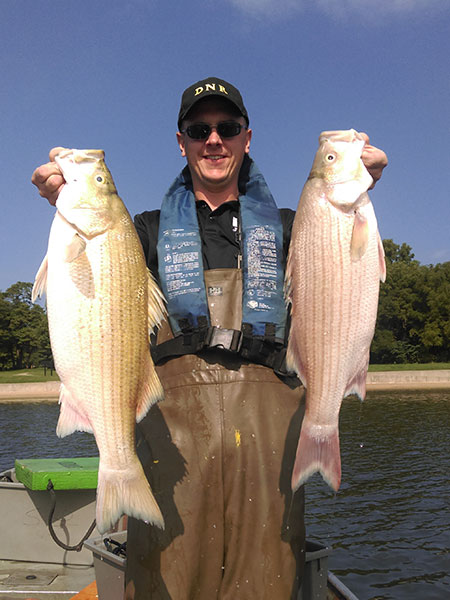By Louie Stout
 Indiana biologist Tom Bacula poses with 10- and 8-pound wipers he captured in nets while studying the wiper population at Potato Creek State Park.
Indiana biologist Tom Bacula poses with 10- and 8-pound wipers he captured in nets while studying the wiper population at Potato Creek State Park.
Indiana biologist Tom Bacula poses with 10- and 8-pound wipers he captured in nets while studying the wiper population at Potato Creek State Park.
When you make out your fishing “to-do” list for next year, consider tackling the hybrid bass that are taking a foothold in Worster Lake at Potato Creek State Park.
Most people don’t know much about these gamefish that have been stocked in the park lake annually since 2011. They were planted by the Indiana DNR with hopes they’d feed heavily on the gizzard shad that have created problems for Worster Lake fish managers for years.
Best known as “wipers,” the fish are a cross between a white bass and the freshwater striped bass. The combination produces the voracious feeding habits of white bass yet one that grows to larger sizes, thanks to the striped bass genetics.
District fisheries biologist Tom Bacula says the wiper fishery is doing well and one that anglers should consider targeting. He was at the lake last fall surveying the population and came away pleasantly surprised.
“I was very impressed with the numbers and size of fish collected, especially with it being a relatively young fishery,” said Bacula. “It appears as though we have all year classes present.”
Bacula said 26 percent of the fish he captured during a brief survey were one year olds from 11 to 14 inches; 38 percent were 15-18 inches, 29 percent were 19-21 inches (3 ½ pounds), five were 22-23 inches, six were 25-26 inches (8-9 pounders) and one was 27.5 inches (10 pounder).
And those were just the fish he captured through an abbreviated netting and electro-shocking survey.
So what do they look like?
Wipers have a streamlined body with a bluish-black back, silver sides and a white belly. The horizontal lines are usually broken, often forming a “W” pattern above the lateral line.
Like striped bass, hybrids have two parallel tooth patches on the center of their tongue. White bass have just one. Hybrids usually weigh 5 to 10 pounds but can be as large as 20 pounds.
They basically are open water feeders, roaming around the deeper areas where schools of shad spend most of the warm water months. Unlike largemouth bass, they don’t relate to cover or structure and tend to suspend off the bottom where they ambush passing schools of shad.
You may catch an occasional wiper from shore, but you’ll have your best luck fishing from a boat that is wired with a good sonar graph. Ease off shore and watch for pods of shad with larger ‘fish’ marks around them.
During the spring, look for wipers to be hanging around the old creek channel, suspended off underwater points and ledges. They will move toward incoming streams in the spring but generally don’t venture far from deep water.
Once the water temperature gets above 70 degrees, they will gather in the deeper end of the lake where they spend most of their time.
During early mornings and late evenings, you may see them blasting shad near the surface. That’s when a large topwaters, such as walking baits that slash from side-to-side, are best.
Lure choices should mimic shad. Try trolling or casting light-colored, deep-running crankbaits or minnow plugs. Jigging or flutter spoons may work, too, and you may get them to take a Carolina rig with large lizard trailing off bottom.
Livebaits work, as some crappie fishermen may attest, but you’re better off with bass minnows or other larger versions. Just remember these fish are big and powerful, so you might want to beef up your fishing line.
Bacula says that most of the wipers he trapped this fall came from areas off the beach.
“We had a net that went through a saddle off the west fishing pier (north of the west access) that did very with numbers and most of the larger fish were caught in that net,” he said.
Looking for a new challenge? The wipers are there. It’s up to you to figure out how to fool ‘em.





